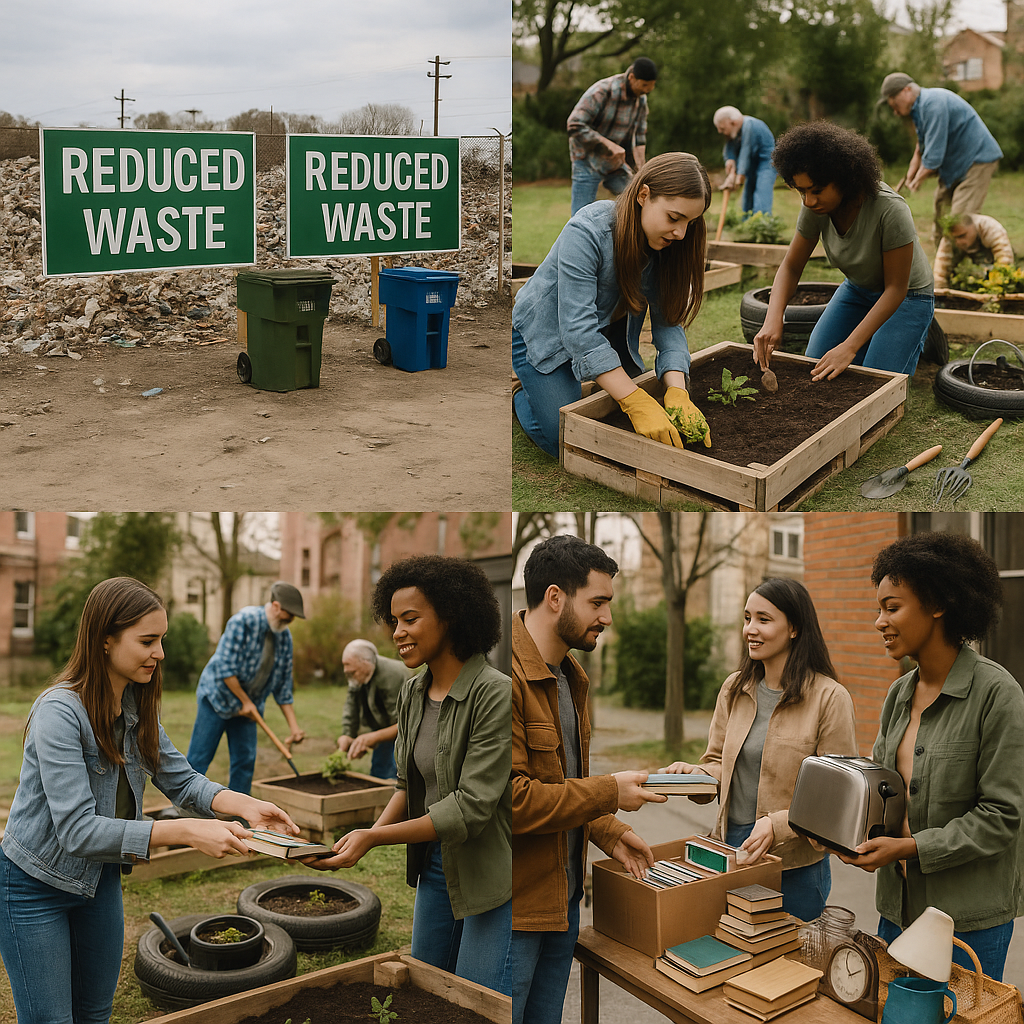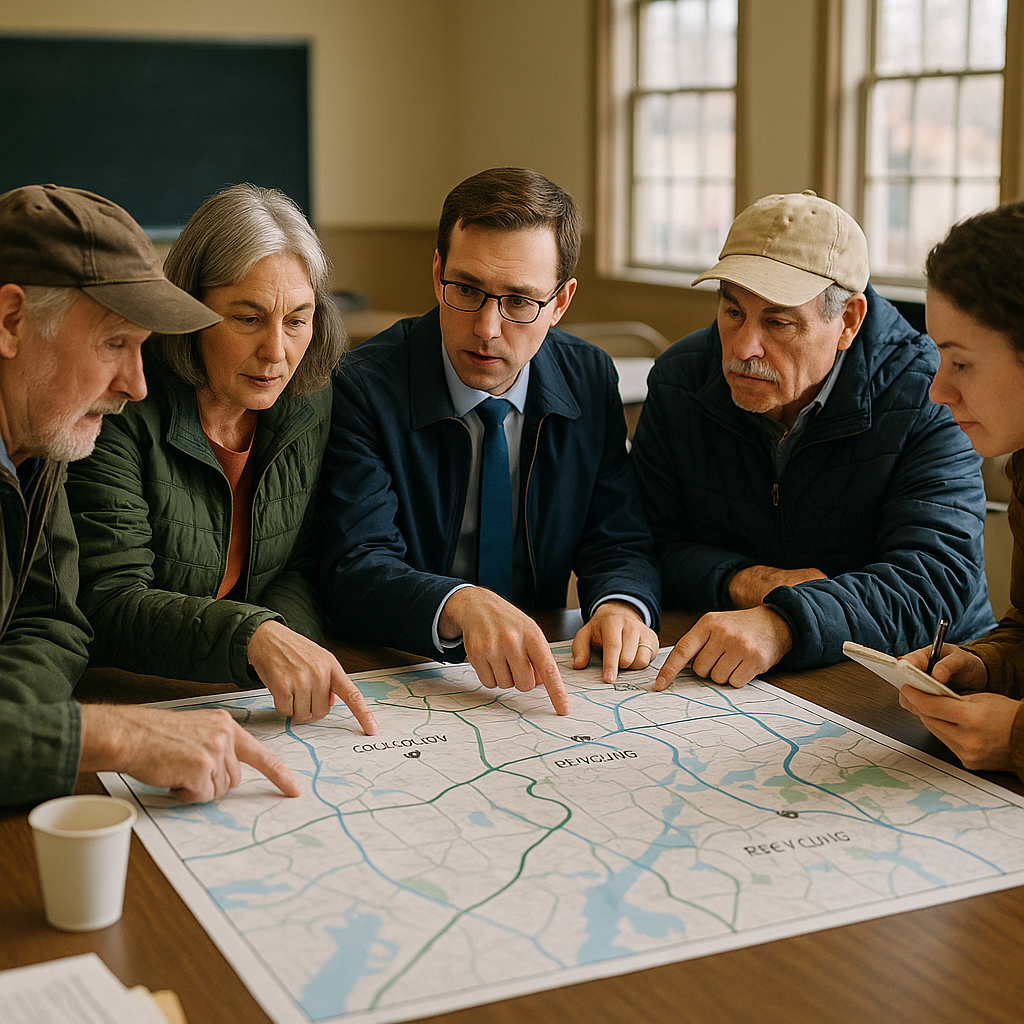5901 Botham Jean Blvd, Dallas, TX 75215
What is a Community Scrap Network?
May 9, 2025Did you know that recycling just one ton of scrap metal saves 3,000 pounds of ore from being mined? This is the remarkable impact of community scrap networks in action. A community scrap network is a collaborative system that brings together local businesses, community organizations, and residents to create an effective metal recycling ecosystem.
These networks function as the backbone of local recycling efforts. They establish accessible drop-off points throughout neighborhoods, create incentive programs for scrap metal collection, and coordinate regular collection events. The primary goal is straightforward but essential: divert valuable metals from landfills and put them back into productive use.
Community scrap networks do more than just process metal. They foster environmental responsibility while strengthening community bonds. When residents, businesses, and local organizations unite around responsible waste management, they create a system that delivers both ecological and economic benefits. From reducing the need for mining raw materials to creating local jobs, these networks transform discarded items into resources that fuel a more sustainable future.
How Can Local Partnerships Enhance Community Scrap Networks?

Local partnerships form the backbone of successful community scrap networks. When businesses, non-profit organizations, and government entities work together, they create powerful systems that maximize resource recovery and community engagement. These collaborations pool expertise and resources that single organizations simply cannot match on their own.
Partnerships with local businesses provide critical infrastructure for collection and processing. Many retailers now offer in-store recycling options, making responsible disposal more accessible for community members. These convenient drop-off locations significantly increase participation rates compared to centralized collection points alone.
Non-profit organizations bring valuable community connections and volunteer networks to scrap initiatives. They understand neighborhood needs and can tailor recycling messaging to resonate with local residents. Their existing community presence helps overcome trust barriers that might otherwise limit participation in recycling programs.
Government partnerships contribute regulatory support and public resources to strengthen scrap networks. Local municipalities can provide essential services like transportation logistics, public space for collection events, and official endorsement that legitimizes recycling efforts. This formal backing often translates into higher community engagement.
Resource Sharing Benefits
Effective partnerships enable efficient resource distribution throughout scrap networks. Organizations can share equipment, transportation fleets, and processing facilities to reduce individual operational costs. This collective approach creates economies of scale that make recycling more financially viable for all participants.
Knowledge sharing represents another crucial benefit. When waste management companies collaborate with community organizations, both gain valuable perspectives. Technical expertise combines with grassroots understanding to create more effective collection strategies and educational outreach.
Financial resource pooling helps overcome budget limitations. A Midwest community partnership between environmental groups and local businesses successfully collected over 50 tons of electronic waste in one year. This achievement would have been impossible without shared funding and staffed collection sites provided by participating organizations.
Community Engagement Through Collaboration
Partnerships dramatically increase community involvement in scrap networks. When residents see familiar local organizations participating, they’re more likely to trust and engage with recycling initiatives. This connection transforms recycling from an abstract environmental concept into a concrete community value.
Collaborative educational programs reach wider audiences than single-organization efforts. When schools partner with recycling companies and environmental groups, students receive comprehensive sustainability education that often extends to their families. These programs build long-term recycling habits through consistent messaging across multiple trusted sources.
Community events organized through partnerships draw larger participation. Scrap metal drives become more effective when local businesses provide collection sites, community groups mobilize volunteers, and media partners promote the events. This combined approach creates excitement and transforms recycling into a social activity rather than just an individual responsibility.
Innovative Partnership Models
Creative partnerships continue to evolve in response to recycling challenges. Some coastal communities have developed collaborations between environmental organizations and fishing industries to collect and recycle old fishing gear. These initiatives prevent marine pollution while recovering valuable materials.
Business-to-business partnerships create closed-loop systems that maximize material recovery. Manufacturing companies partner with specialized recyclers to recapture production scraps and reintroduce them into new products. These arrangements reduce waste while providing cost savings to both parties.
Public-private partnerships offer especially powerful frameworks for community scrap networks. When government incentives align with business capabilities and community needs, recycling systems become both economically sustainable and environmentally effective. These collaborations often produce innovative solutions that no single sector could develop independently.
Retail partnerships with recycling providers create convenient collection points that address common participation barriers. When shoppers can drop off recyclables during regular shopping trips, compliance rates increase significantly. These arrangements benefit retailers through increased foot traffic while supporting community recycling goals.
Educational institutions make valuable partners in scrap networks. Schools and universities not only serve as collection sites but also integrate recycling education into their curriculum. Students often become recycling ambassadors within their families, spreading sustainable practices beyond campus boundaries.
Faith-based organizations increasingly participate in community recycling partnerships. These institutions reach community members who might not otherwise engage with environmental initiatives. Their participation frames recycling as a moral responsibility, adding powerful motivation beyond environmental or economic benefits.
What Are the Key Benefits of Community Scrap Networks?

Community scrap networks transform how neighborhoods handle waste materials. These systems create organized pathways for collecting, sorting, and processing recyclable materials that would otherwise end up in landfills. Their strategic approach to waste management yields substantial environmental, economic, and social advantages.
Environmental Impact
The primary environmental benefit of community scrap networks is waste diversion. By redirecting materials from landfills, these networks significantly reduce the volume of waste requiring disposal. A single ton of recycled scrap metal saves approximately 3,000 pounds of ore from being mined, demonstrating the substantial resource conservation these networks enable.
These networks also contribute to greenhouse gas reduction. When communities process materials locally rather than shipping them to distant facilities, they minimize transportation emissions. The EPA has documented how effective recycling programs can substantially lower a community’s carbon footprint through reduced landfill methane emissions and decreased energy consumption in manufacturing.
Additionally, community scrap networks promote sustainable resource management. They extend the useful life of valuable materials by facilitating their collection and reprocessing. This conservation approach preserves natural resources while reducing the environmental damage associated with extracting virgin materials.
Economic Advantages
Community scrap networks generate significant cost savings for local governments and residents. Municipalities spend less on landfill maintenance and expansion when waste volumes decrease. These savings often translate to lower waste management fees for community members.
These networks also stimulate job creation across various sectors. From collection and sorting to processing and manufacturing with recycled content, community recycling initiatives support employment opportunities. Studies show recycling creates more jobs per ton of waste than traditional disposal methods.
Participants in community scrap networks may also benefit from revenue streams through the sale of collected materials. Many networks establish partnerships with recycling facilities that pay for quality recyclables, creating economic incentives for community participation.
| Aspect | Details |
|---|---|
| Total Economic Activity | $109.78 billion annually |
| Jobs Supported | 500,000 jobs |
| State and Local Tax Revenue | $4.4 billion annually |
| Federal Tax Revenue | $6.8 billion annually |
| Export Contribution | 26.8% of industry activity |
| Energy Savings (Aluminum) | 95% less energy |
| Energy Savings (Steel) | 74% less energy |
Community Building and Education
Perhaps most importantly, these networks foster community ownership of environmental solutions. When neighbors collaborate on recycling initiatives, they develop shared responsibility for sustainability. This collective approach strengthens community bonds while addressing environmental challenges.
Scrap networks also serve as powerful educational platforms. They raise awareness about resource conservation and waste management through hands-on participation. Community members gain practical knowledge about materials, their value, and proper recycling techniques.
The networks enhance public engagement in sustainability efforts by making recycling accessible and meaningful. Rather than viewing recycling as an individual burden, participants experience it as a rewarding community activity with visible benefits.
Circular Economy Development
Community scrap networks play a crucial role in developing local circular economies. They establish infrastructure for collecting and processing materials, which supports businesses that manufacture with recycled content. This closed-loop system keeps resources within the community while reducing dependence on external material sources.
The networks also encourage innovative approaches to waste reduction. Communities often discover creative reuse opportunities for materials that might otherwise lack recycling pathways. These innovations frequently lead to unique local solutions that address specific community needs.
By strengthening local supply chains for recycled materials, these networks increase community resilience. They reduce dependence on virgin resources while creating sustainable material flows that can withstand external disruptions.
- Reduced disposal costs through decreased landfill usage
- Lower environmental impact from minimized resource extraction
- Strengthened community relationships through collaborative sustainability efforts
- Enhanced public awareness about waste management and recycling practices
- Improved local economies through job creation and material revenues
- Development of sustainable, resilient material supply chains
Community scrap networks represent a practical approach to sustainability that delivers multiple benefits simultaneously. Their impact extends beyond environmental protection to include economic development, education, and community building. As more communities establish these networks, they create interconnected systems that advance regional sustainability while addressing local needs.
How to Implement a Successful Community Scrap Network?

Creating a thriving community scrap network requires strategic planning and collaborative effort. A well-organized network not only diverts valuable materials from landfills but also strengthens community bonds and promotes environmental stewardship. Follow these essential steps to build an effective scrap network in your community.
Identify Key Stakeholders
The foundation of any successful community scrap network begins with identifying the right stakeholders. These are the individuals and organizations who will drive your initiative forward. Start by mapping potential partners who have interests aligned with recycling and sustainability.
Local businesses often serve as cornerstone partners, especially those that generate significant recyclable waste or have sustainability goals. Schools and educational institutions provide access to younger generations and often have existing environmental initiatives. Civic organizations bring community connections and volunteer power that can significantly boost your network’s reach.
When approaching potential stakeholders, focus on how participation benefits them directly. For businesses, highlight potential cost savings from reduced waste disposal. For schools, emphasize educational opportunities and potential fundraising through collected materials.
Create a Shared Vision and Clear Goals
A unified vision gives your scrap network purpose and direction. Gather your identified stakeholders for planning sessions where everyone can contribute ideas. Use these sessions to establish what success looks like for your community specifically.
Start with realistic, measurable goals that address your community’s unique needs. These might include diverting a specific tonnage of scrap materials from landfills annually, engaging a certain number of community members, or raising funds for local projects through recycling efforts.
Document your vision and goals in a straightforward plan that includes:
- Mission statement that captures your network’s purpose
- Specific, measurable objectives with timeframes
- Roles and responsibilities for each stakeholder group
- Methods for tracking and measuring progress
- Timeline for implementation phases
This documented plan serves as both a roadmap and a tool for communicating your initiative to the broader community.
Develop Strong Partnerships
Strong partnerships form the operational backbone of your scrap network. Move beyond simple stakeholder identification to developing genuine collaborative relationships. This requires establishing clear communication channels and mutual benefit for all involved.
Create formal partnership agreements that outline expectations, responsibilities, and benefits for each participant. Regular meetings help maintain momentum and allow partners to address challenges collectively. Remember that transparency builds trust, especially when handling materials that have potential value.
Consider reaching out to waste management companies and local recycling centers early in your planning process. Their expertise in material handling and existing infrastructure can provide valuable insights for your network design.
Establish Accessible Collection Infrastructure
For community members to participate, your scrap network needs convenient, accessible collection points. The easier you make participation, the more successful your network will be.
Strategic placement of drop-off locations is crucial. Consider high-traffic areas like community centers, school parking lots, or shopping centers. Each location should have clear signage explaining acceptable materials and preparation requirements.
Your collection infrastructure should include:
- Permanent drop-off locations with regular hours
- Temporary collection events in underserved areas
- Secure containers that protect materials from weather
- Clear instructions for material preparation
- Volunteer or staff presence during peak times
For larger communities, consider a hub-and-spoke model where smaller collection points feed into a central processing location. This allows for more efficient sorting and distribution of materials.
Create Incentives for Participation
Incentives significantly boost community involvement in recycling initiatives. Design a mix of incentives that appeal to different motivations within your community.
Financial incentives might include payments for high-value scrap materials or discounts at participating local businesses. Recognition programs that highlight top contributors can tap into people’s desire for community acknowledgment. Educational incentives like workshops or school programs connect participation to learning opportunities.
Consider implementing a points-based reward system where participants earn credits for consistent contributions. These points could be redeemed for local products or services, creating a circular benefit within your community economy.
Launch Educational Campaigns
Education forms the foundation of sustainable community participation. Many people want to recycle properly but lack specific knowledge about what materials are valuable and how to prepare them.
Develop educational materials that clearly explain which scrap materials can be recycled, how they should be prepared, and where they can be dropped off. Use multiple communication channels including social media, local newspapers, community bulletin boards, and direct mail to reach diverse audiences.
Hands-on workshops provide valuable learning opportunities. Consider hosting demonstrations at community events where people can learn proper material preparation techniques. School programs can build awareness among younger community members who often become enthusiastic advocates at home.
Remember that education isn’t a one-time effort. Regular updates keep your community informed about program changes, success stories, and the positive impact their participation creates.
Monitor, Evaluate, and Adapt
Continuous improvement depends on regular monitoring and evaluation. Track key metrics from the start to measure your network’s performance against established goals.
Important metrics to track include volume of materials collected, number of active participants, contamination rates, and processing costs. Regular surveys help gauge community satisfaction and identify barriers to participation.
Use this data to make informed adjustments to your program. Perhaps certain collection points need better signage, or educational materials need clarification about specific materials. Being responsive to feedback demonstrates your commitment to the community and helps build long-term loyalty to your program.
Celebrate Success and Share Impact
Public recognition of achievements creates momentum for continued participation. Regular communication about your network’s impact helps community members understand how their individual actions contribute to collective success.
Share detailed statistics about materials diverted from landfills, environmental benefits like reduced emissions or water savings, and economic impacts such as jobs created or money saved. Use compelling visuals and real-world comparisons that help people grasp the significance of these numbers.
Community celebrations like annual recognition events provide opportunities to thank participants and partners while generating renewed excitement for your initiative. These events also create natural opportunities for local media coverage, extending your message to new potential participants.
No table output available
Conclusion: The Future of Community Scrap Networks
Community scrap networks offer a transformative approach to waste management that benefits both local environments and economies. These networks create resilience by reducing dependency on external waste facilities while empowering communities to take control of their recycling future. The collaboration between municipalities, businesses, and residents creates a powerful framework for reaching higher recycling rates and diverting valuable materials from landfills.
As sustainability becomes increasingly important across society, well-organized community scrap networks will play a vital role in building circular economies at the local level. These systems not only address immediate waste challenges but also foster environmental stewardship that can spread throughout communities and create lasting positive change.
If you’re looking to improve recycling operations or develop sustainable waste management solutions for your community or business, contact Okon Recycling at 214-717-4083. Our expertise can help you navigate the complexities of modern recycling and create effective, sustainable waste management systems.
